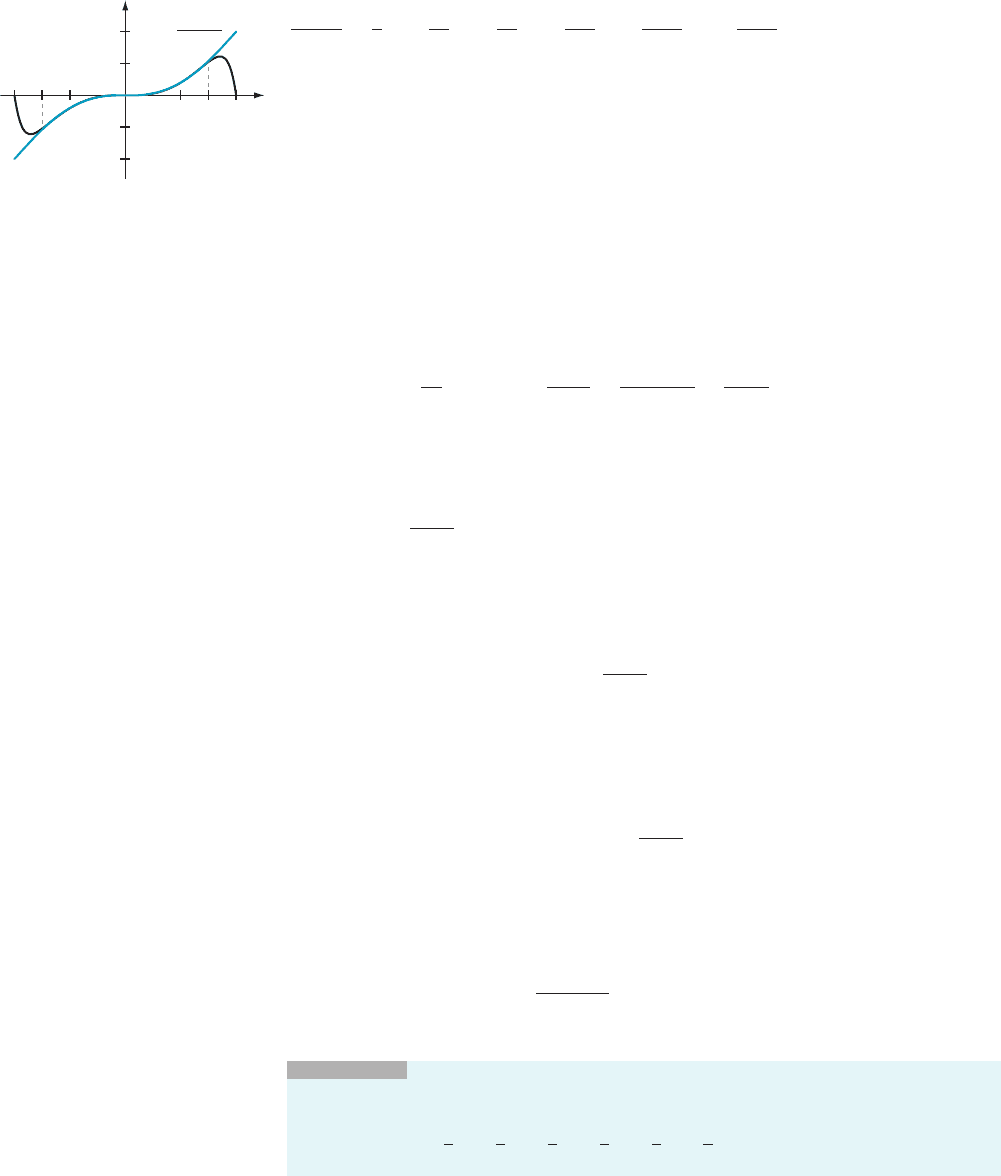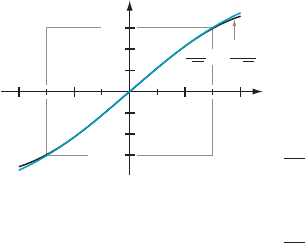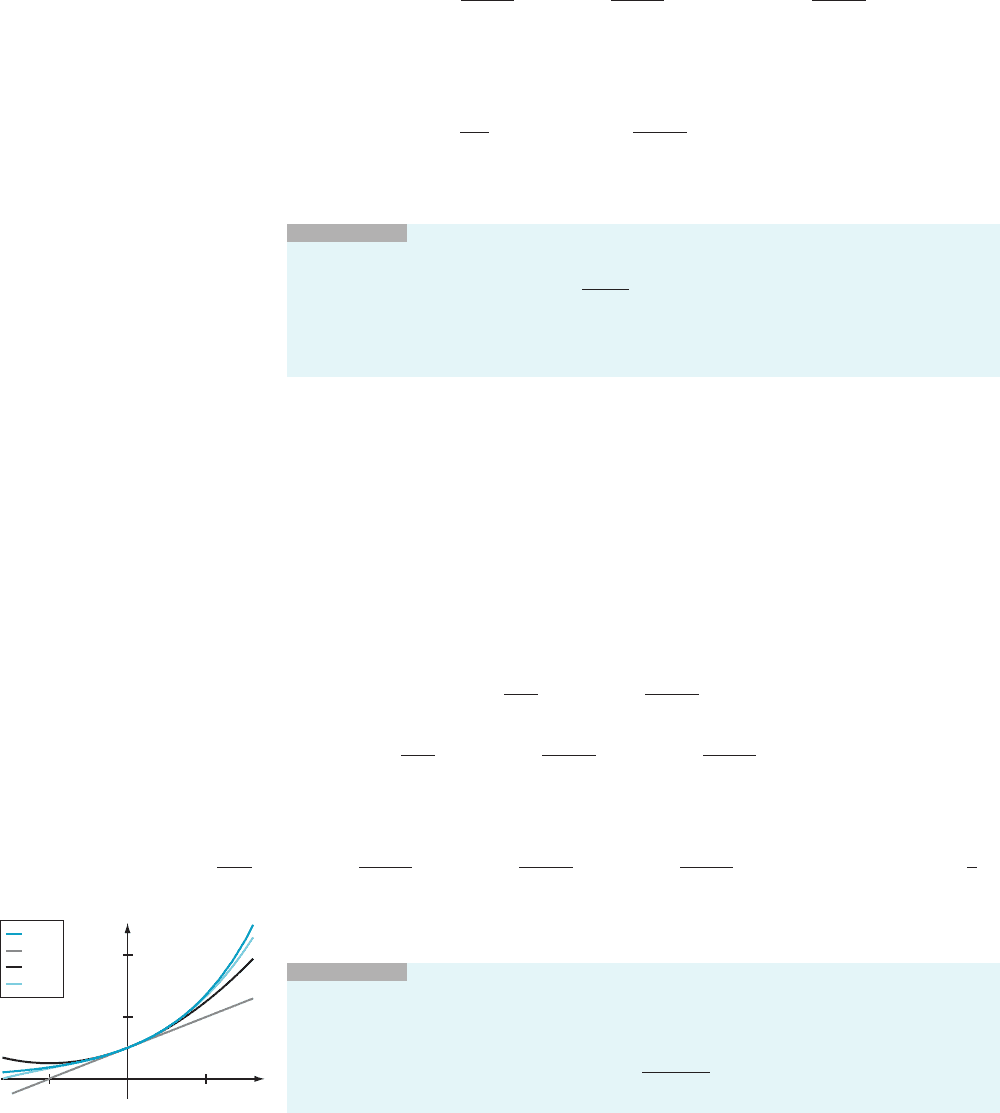Blank B.E., Krantz S.G. Calculus: Single Variable
Подождите немного. Документ загружается.


59. [α, β)
60. [α, β]
61. Is it possible for a power series to have interval of con-
vergence (2N, 1)? Could it have interval of convergence
(0,N)? Explain your answers.
62. What is the radius of convergence of
P
N
n51
n! ðx=nÞ
n
?
63. Let a
n
5
P
n
k51
1=k
2
. What is the radius of convergence of
P
N
n51
a
n
x
n
?
64. Let b
n
5
P
n
k51
1=
ffiffiffi
k
p
. What is the radius of convergence
of
P
N
n51
b
n
x
n
?
65. Suppose that a
n
6¼0 for n $ 0. Show that if
‘ 5 lim
n-N
ja
n11
j=ja
n
j exists (as a nonnegative number or
N), then R 5 1/‘ is the radius of convergence of
P
N
n50
a
n
x
n
. Hint: Follow Examples 6 and 7, and apply the
Ratio Test to the series
P
N
n50
u
n
where u
n
5 a
n
x
n
.
66. Let a
1
5 1, a
2
5 0, a
3
5 3
23
, a
4
5 a
5
5 0, a
6
5 6
26
, a
7
5 a
8
5
a
9
5 0, a
10
5 10
210
, and, in general, a
N
5 N
2N
if N 5
n(n 1 1)/2 for some positive integer n and a
N
5 0 otherwise.
Calculate the radius of convergence of
P
N
n50
a
n
x
n
67. For each odd positive integer n, let a
n
5 n. For each even
positive integer n, let a
n
5 2a
n21
. Calculate the radius of
convergence of
P
N
n51
a
n
x
n
.
Calculator/Computer Exercises
68. We know the validity of the equation
P
N
n50
ð21Þ
n
x
n
5
1=ð1 1 xÞ for 21 , x , 1. In this exercise, we will explore
this equation by graphing partial sums S
N
ðxÞ5
P
N
n50
ð21Þ
n
x
n
of
P
N
n50
ð21Þ
n
x
n
for several values of N.
a. Plot f (x) 5 1/(1 1 x) for 20.6 , x , 0.6. In the same
window, first add the plot of S
2
(x), then the plot of
S
4
(x), and finally S
6
(x). You will notice the increasing
accuracy as N increases. In this window, the graphs of
S
20
(x) and f (x) would not be distinguishable because
the functions agree to four decimal places.
b. Repeat part a but plot over the interval 0.6 , x , 0.95.
Notice that the convergence of S
N
(x) is less rapid as x
moves away from the center 0 of the interval of con-
vergence. If you are working with a computer algebra
system, replace the plot of S
6
(x) with a plot of S
50
(x). You
will see that, for x in the interval of convergence but near
an endpoint, S
N
(x) can be used to accurately approximate
f (x), but a large value of N mayberequired.
c. Repeat part a but plot over the interval 20.98 , x ,
20.6. Here the problem is that the function f (x) has a
singularity at the left endpoint 21 of the interval of
convergence of the power series.
69. We know the validity of the equation
P
N
n50
x
n
5 1=ð1 2 xÞ
for 21 , x , 1. In this exercise, we will explore this
equation by graphing partial sums S
N
ðxÞ5
P
N
n50
x
n
of
P
N
n50
x
n
for several values of N.
a. Plot f (x) 5 1/(1 2 x) for 20.6 , x , 0.6. In the same
window, first add the plot of S
2
(x), then the plot of
S
4
(x), and finally S
6
(x). You will notice the increasing
accuracy as N increases. In this window, the graphs of
S
20
(x) and f (x) would not be distinguishable because
the functions agree to four decimal places.
b. Repeat part a but plot over the interval 20.95 , x ,
20.6. Notice that the convergence of S
N
(x) is less rapid
as x moves away from the center 0 of the interval of
convergence. If you are working with a computer
algebra system, replace the plot of S
6
(x) with a plot of
S
50
(x). You will see that, for x in the interval of con-
vergence but near an endpoint, S
N
(x) can be used to
accurately approximate f (x), but a large value of N
may be required.
c. Repeat part a but plot over the interval 0.6 , x , 0.98.
Here the problem is that the function f (x) has a sin-
gularity at the right endpoint 1 of the interval of
convergence of the power series.
70. It is known that the equation
P
N
n50
nx
n
5 x =ðx 2 1Þ
2
holds
for 21 , x , 1. In this exercise, we will explore this
equation by graphing partial sums S
N
ðxÞ5
P
N
n50
nx
n
of
P
N
n50
nx
n
for several values of N.
a. Plot f (x) 5 x/(x 2 1)
2
for 20.5 , x , 0.5. In the same
window, first add the plot of S
2
(x), then the plot of
S
4
(x), and finally S
8
(x). You will notice the increasing
accuracy as N increases.
b. Repeat part a but plot over the interval
20.8 , x ,20.5. Notice that the convergence of S
N
(x)
is less rapid as x moves away from the center 0 of the
interval of convergence. If you are working with a
computer algebra system, replace the plot of S
8
(x)
with a plot of S
20
(x). You will see that, for x in the
interval of convergence but near an endpoint, S
N
(x)
can be used to accurately approximate f (x), but a large
value of N may be required.
c. Repeat part a but plot over the interval 0.5 , x , 0.9. If
you are working with a computer algebra system,
replace the plot of S
8
(x) with a plot of S
25
(x).
71. We know that
P
N
n50
ð21Þ
n
t
n
5 1=ð1 1 tÞ for 21 , t , 1.
Therefore for 21 , x , 1, we have
lnð1 1 xÞ5
Z
x
0
1
1 1 t
dt 5
Z
x
0
X
N
n50
ð21Þ
n
t
n
dt:
In this exercise, we will investigate graphically the
approximation that results when an infinite series is
truncated and then integrated term by term.
a. Plot f (x) 5 ln(1 1 x) for 20.5 # x # 1. In the same
window, first add the plot of S
N
ðxÞ5
R
x
0
P
N
n50
ð21Þ
n
t
n
dt for N 5 2, then the plot of S
4
(x),
and finally S
6
(x). You will notice the increasing accu-
racy as N increases. In this window, the graphs of
S
50
(x) and f (x) would be distinguishable only at the
rightmost few pixels.
b. Repeat part a but plot over the interval 20.99 , x ,
20.5. Here the problem is that the function f (x) has a
8.6 Introduction to Power Series 685

singularity at the left endpoint 21 of the interval of
convergence of the power series. Still, accuracy in the
interval of convergence can be attained by increasing
the value of N. If you are working with a computer
algebra system, replace the plot of S
6
(x) with a plot of
S
50
(x).
8.7 Representing Functions by Power Series
A natural question to ask is, if a power series defines a function, can we always say
what funct ion it is? The answer is, No. Most functions, those defined by power
series included, do not have familiar names. A more fruitful question is, can we
write the functions with which we are familiar as power series? The answer to this
question is, with certain restrictions, Yes. Beginning with this section, we will study
how to go back an d forth between functions and power series.
Power Series
Expansions of Some
Standard Functions
For each fixed x, the power series
P
N
n50
x
n
can be regarded as a geometric series.
Because we know that this series converges to 1/(1 2 x)ifx belongs to the interval
(21, 1), we have
1
1 2 x
5
X
N
n50
x
n
5 1 1 x 1 x
2
1 x
3
1 ð21 , x , 1Þ:
This formula can be used to find power series representations for many functions
that are related to 1/(1 2 x). To facilitate substitution, we rewrite this equation with
a different variable:
1
1 2 u
5
X
N
n50
u
n
5 1 1 u 1 u
2
1 u
3
1 ð21 , u , 1Þ: ð8:7:1Þ
⁄ EX
AMPLE 1 Express
x
3
ð4 1 x
2
Þ
by means of a power series with base point 0.
Solution The
key idea is to rewrite the denominator of the given function in the
form 1 2 u and then use formula (8.7.1). We accomplish this manipulation by
writing
1
4 1 x
2
5
1
4
1 2 ð2x
2
=4Þ
5
1
4
1
ð1 2 uÞ
;
where u 52x
2
/4. If 22 , x , 2, then 21 , u , 1. Substituting u 52x
2
/4 in equation
(8.7.1), we obtain
1
4 1 x
2
5
1
4
1
ð1 2 uÞ
5
ð8:7:1Þ
1
4
X
N
n50
u
n
5
1
4
X
N
n50
2
x
2
4
n
ð22 , x , 2Þ:
We conclude that
x
3
4 1 x
2
5
x
3
4
X
N
n50
2
x
2
4
n
5
X
N
n50
ð21Þ
n
1
4
n11
x
2n13
ð22 , x , 2Þ:
If we write out several terms, then this equation becomes
686 Chapter 8 Infinite Series

x
3
4 1 x
2
5
1
4
x
3
2
1
16
x
5
1
1
64
x
7
2
1
256
x
9
1
1
1024
x
11
2
1
4096
x
13
|fflfflfflfflfflfflfflfflfflfflfflfflfflfflfflfflfflfflfflfflfflfflfflfflfflfflfflfflfflfflfflfflfflfflfflfflfflfflfflfflfflfflfflfflfflfflfflffl{zfflfflfflfflfflfflfflfflfflfflfflfflfflfflfflfflfflfflfflfflfflfflfflfflfflfflfflfflfflfflfflfflfflfflfflfflfflfflfflfflfflfflfflfflfflfflfflffl}
PðxÞ
1 22 , x , 2:
Figure 1 shows that the degree 13 polynomial P(x) that we obtain by truncating the
infinite series is quite a good approximation to x
3
/(4 1 x
2
) for x not too far away
from the center of the interval of convergence. In the figure, the plots of x
3
/(4 1 x
2
)
and P(x) are barely distinguishable for 21.5 , x , 1.5.
¥
⁄ EXAMPLE 2 Find a power series representation for the function F(x) 5
ln(1 1 x).
Solution The
relationship of F to formula (8.7.1) becomes apparent after
differentiation:
FuðxÞ5
d
dx
lnð1 1 xÞ5
1
1 1 x
5
1
1 2 ð2xÞ
5
1
1 2 u
where u 52x:
For 21 , x , 1, we also have 21 , u , 1. We may therefore apply formula (8.7.1)
to obtain
FuðxÞ5
1
1 2 u
5
ð8:7:1Þ
X
N
n50
u
n
5
X
N
n50
ð2xÞ
n
5
X
N
n50
ð21Þ
n
x
n
ð21 , x , 1Þ:
Next, we integrate both sides of this equation. Theorem 5b of Section 8.6 tells us
that the right-hand side may be integrated termwise. The result is
FðxÞ5
X
N
n50
ð21Þ
n
x
n11
n 1 1
1 C ð 21 , x , 1Þ;
where C is a constant of integration. By setting x 5 0 in this equation, we obtain
F(0) 5 C. Because F(0) 5 ln(1 1 0) 5 0, we conclude that C 5 0. Thus we have
derived the formula
lnð1 1 xÞ5
X
N
n50
ð21Þ
n
x
n11
n 1 1
ð21 , x , 1Þ:
It is not wrong to leave the series in this form, but we prefer to simplify the
exponent to which x is raised. By changing the index of summation to m 5 n 1 1, we
obtain
lnð1 1 xÞ5
X
N
m51
ð21Þ
m21
m
x
m
ð21 , x , 1Þ: ð8:7: 2aÞ ¥
INSIGHT
It is usually a good idea to write out the first several terms of a new series
as a visual aid. For instance, equation (8.7.2a) becomes
lnð1 1 xÞ5 x 2
1
2
x
2
1
1
3
x
3
2
1
4
x
4
1
1
5
x
5
2
1
6
x
6
1
1
7
x
7
2
:::
for 21 , x , 1: ð8:7: 2bÞ
1.5
1.5
1.0
0.5
0.5
1.0
x
y
P(x)
x
3
4
x
2
m Figure 1
8.7 Representing Functions by Power Series 687

⁄ EXAMPLE 3 Use formula (8.7.2b) to calculate ln(1.1) with an error no
greater than 0.0001.
Solution Formul
a (8.7.2b) tells us that
lnð1:1Þ5 lnð1 1 0:1Þ5 0:1 2
1
2
ð0:1Þ
2
1
1
3
ð0:1Þ
3
2
1
4
ð0:1Þ
4
1
We can estimate this quantity by truncating the alternating infinite series.
According to inequality (8.4.1) of the Alternating Series Test, the error that results
is less than the first term that is omitted. Therefore
lnð1 1 0:1 Þ5 0:1 2
1
2
ð0:1Þ
2
1
1
3
ð0:1Þ
3
1 ε
where ε is an error that is less than
1
4
(0.1)
4
5 0.000025 in absolute value. The
required approximation is
lnð1:1Þ0:1 2
1
2
ð0:1Þ
2
1
1
3
ð0:1Þ
3
5 0:09533::::
A check with a calculator will verify the indicated accuracy.
¥
⁄ EXAMPLE 4 Find a power series expansion for F(x) 5 arctan (x) that is
valid for 21 , x , 1.
Solution We
use the same idea that was the basis of Example 2. Our starting
point is
FuðxÞ5
d
dx
arctanðxÞ5
1
1 1 x
2
5
1
1 2 u
where u 52x
2
:
Notice that 21 , u # 0 for 21 , x , 1. For these values of u, the geometric series
P
N
n50
u
n
converges to 1/(1 2 u). Therefore
FuðxÞ5
1
1 2 u
5
ð8:7:1Þ
X
N
n50
u
n
5
X
N
n50
ð2x
2
Þ
n
5
X
N
n50
ð21Þ
n
x
2n
ð21 , x , 1Þ:
Now we find antiderivatives of both sides. The result is
arctanðxÞ5
X
N
n50
ð21Þ
n
x
2n11
2n 1 1
1 C ð 21 , x , 1Þ:
Setting x 5 0 shows that C 5 arctan(0) 5 0. Therefore
arctanðxÞ5
X
N
n50
ð21Þ
n
x
2n11
2n 1 1
ð21 , x , 1Þ; ð8:7:3aÞ
or, in a form that is more easily recogn ized and remembered,
arctanðxÞ5 x 2
1
3
x
3
1
1
5
x
5
2
1
7
x
7
1
1
9
x
9
2 for 21 , x , 1: ð8:7:3bÞ ¥
688 Chapter 8 Infinite Series

INSIGHT
Power series representations (8.7.2b) and (8.7.3b) for ln(1 1 x) and
arctan (x) are valid for 21 , x , 1. The Alternating Series Test tells us that the series
in these formulas converge when x 5 1 as well. Because each side of equations (8.7.2b)
and (8.7.3b) makes sense for x 5 1, it is plausible to think that these equations remain
valid for x 5 1. That is,
lnð2Þ5 1 2
1
2
1
1
3
2
1
4
1
1
5
2
1
6
1
1
7
2 ð8:7:4Þ
and, because arctan (1) 5 π/4,
π
4
5 1 2
1
3
1
1
5
2
1
7
1
1
9
2 ð8:7:5Þ
In fact, both of these formulas are true. Proving them requires a delicate interchange of
limits that we will omit. Although formulas (8.7.4) and (8.7.5) are interesting, they are
not very efficient from a computational viewpoint. For instance, after summing the first
100 terms that appear on the right side of formula (8.7.5), we get
π
4
1 2
1
3
1
1
5
2
1
7
1
1
9
2
1
11
1 2
1
199
5 0:7828982::::
This results in the approximation π 4 3 0.7828982 . . . 5 3.131 ..., which is correct to
only one decimal place!
Thus far, the base point used in all examples of this section has been 0. At
times, other base points may be desirable or, as in the next example, necessary.
⁄ EX
AMPLE 5 Expand 1/x and 1/x
2
in powers of x 2 1 for jx 2 1j, 1.
Solution First
notice that, on applying formula (8.7.1) with u 5 12 x, we have
1
x
5
1
1 2 ð1 2 xÞ
5
ð8:7:1Þ
X
N
n50
ð1 2 xÞ
n
5
X
N
n50
ð21Þ
n
ðx 2 1Þ
n
; jx 2 1j, 1:
Differentiating both sides of this equation, we obtai n 21=x
2
5
P
N
n51
nð21Þ
n
ðx 2 1Þ
n21
,or1=x
2
5
P
N
n51
nð21Þ
n21
ðx 2 1Þ
n21
for jx 2 1j, 1. To write this power
series in standard form, we set m 5 n 2 1. As n runs through the integers from 1 to
infinity, the index m runs through the integers from 0 to infinity. This change of
summation index gives us
1
x
2
5
X
N
m50
ð21Þ
m
ðm 1 1Þðx 2 1Þ
m
for jx 2 1j, 1:
If we write out several terms, then we obtain
1
x
2
5 1 2 2 ðx 2 1Þ1 3ðx 2 1Þ
2
2 4ðx 2 1Þ
3
1 for jx 2 1j, 1: ð8:7:6Þ ¥
A LOOK FORWARD c Every power series representation that we have obtained so
far has been derived from the identity 1=ð1 2 xÞ5
P
N
n50
x
n
for |x| , 1. It is sur-
prising, perhaps, that functions such as ln(1 1 x) and arctan(x) can be treated using
this approach. These examples should not, however, lead us to overestimate the
8.7 Representing Functions by Power Series 689

scope of the techniques that have been presented. Power series representations of
other important funct ions such as e
x
, sin(x), and cos(x) require the more general
methods that we develop in the next section.
The Relationship
between the
Coefficients and
Derivatives
of a Power Series
Theorem 6 of Section 8.7 tells us that, if a power series
P
N
n50
a
n
ðx2cÞ
n
converges on
an open interval I centered at c,thenthefunctionf (x) defined by f ðxÞ5
P
N
n50
a
n
ðx 2 cÞ
n
is infinitely differentiable on I. In other words, the n
th
derivative
f
(n)
(c)off at c exists for every positive integer n. The next theorem tells us that the
coefficient a
n
can be expressed in terms of f
(n)
(c). To avoid having to treat the index
n 5 0 as a special case, it will be convenient to understand f
(0)
(c)tomeanf (c).
THEOREM 1
Suppose that the power series
P
N
n50
a
n
ðx2cÞ
n
converges on an
open interval I centered at c. Let f be the function defined on I by f ðxÞ5
P
N
n50
a
n
ðx 2 cÞ
n
: Then
a
n
5
f
ðnÞ
ðcÞ
n!
; n 5 0; 1; 2; 3;::: ð8:7:7Þ
and
f ðxÞ5
X
N
n50
f
ðnÞ
ðcÞ
n!
ðx 2 cÞ
n
: ð8:7:8Þ
Proof. Bec
ause a
0
5 f (c) 5 f
(0)
(c) 5 f
(0)
(c)/0!, equation (8.7.7) holds when k 5 0.
Now suppose that k is a positive integer. Observe that
d
k
dx
k
ðx 2 cÞ
n
5
0ifn , k
k! if n 5 k
nðn 2 1Þðn 2 k 1 1Þðx 2 cÞ
n2k
if n . k
:
8
<
:
From the last line of this equation, we see that
d
k
dx
k
ðx 2 cÞ
n
x5c
5 n ðn 2 1Þðn 2 k 1 1Þðc 2 cÞ
n2k
5 0
when n . k. By dividing the power series for f (x) into three parts,
f ðxÞ5
X
k21
n50
a ðx 2 cÞ
n
|fflfflfflfflfflfflfflfflfflffl{zfflfflfflfflfflfflfflfflfflffl}
n,k
1 a
k
ðx 2 cÞ
k
|fflfflfflfflfflffl{zfflfflfflfflfflffl}
n5k
1
X
N
n5k11
a
n
ðx 2 c Þ
n
|fflfflfflfflfflfflfflfflfflfflfflffl{zfflfflfflfflfflfflfflfflfflfflfflffl}
n.k
;
and differentiating k times term by term, we see that
f
ðkÞ
ðxÞ5 0 1 k! a
k
1
X
N
n5k11
nðn 2 1Þðn 2 k 1 1Þa
n
ðx 2 c Þ
n2k
and
f
ðkÞ
ðcÞ5 0 1 k! a
k
1 0:
690 Chapter 8 Infinite Series

Equation (8.7.7) follows. Formula (8.7.8) is then obtained by substituting the value
equation (8.7.7) gives for a
n
into f ðxÞ5
P
N
n50
a
n
ðx 2 cÞ
n
: ’
⁄ EXAMPLE 6 Let f ð x Þ5
P
N
n50
ð21Þ
n
ðn 1 1Þðx 2 1Þ
n
. What are f uð1Þ; f vð1Þ,
and f wð1Þ?
Solution The
coefficients {a
n
} of the power series defining f are given by
a
n
5 (21)
n
(n 1 1) for 0 # n ,N. The base point is c 5 1. Because
‘ 5 lim
n-N
a
n11
a
n
5 lim
n-N
n 1 2
n 1 1
5 lim
n-N
1 1 2=n
1 1 1=n
5 1;
we see that the radius of convergence R is given by R 5 1/‘ 5 1. All that is needed to
apply Theorem 1 is that R . 0. We may therefore use formula (8.7.7), which tells us
that f
(k)
(c) 5 k! a
k
. Consequently, on setting k 5 1, 2, and 3, we have f uð1Þ5
1! a
1
5 1! ð21Þ
1
ð1 1 1Þ522; f vð1Þ5 2! a
2
5 2! ð21Þ
2
ð2 1 1Þ5 6; and f wð1Þ5 3!
a
3
5 3! ð21Þ
3
ð3 1 1Þ5224: ¥
INSIGHT
Notice that the formula f
(k)
(c) 5 k! a
k
permits the calculation of f
(k)
(c)
without the benefit of a closed form for f (x). However, equation (8.7.6) shows that the
power series that defines f (x) in Example 6 is equal to 1/x
2
. In other words, the function
f (x) of Example 6 is equal to 1/x
2
. We may therefore check the results of Example 6 by
directly calculating f uðxÞ522/x
3
, f vðxÞ5 6/x
24
, and f wðxÞ5224/x
5
. On evaluation at
x 5 1, we obtain f uð1Þ522, f vð1Þ5 6, and f wð1Þ5224, in agreement with the values
obtained by using the formula f
(k)
(c) 5 k! a
k
.
In Example 6, the coeffic ient a
k
of a power series representing a function f is
used to calculate f
(k)
(c). In the next example, equation (8.7.7) is applied in the
opposite direction: f
(k)
(c) is used to calculate a
k
.
⁄ EX
AMPLE 7 The error function x/erf (x) is defined by
erfðxÞ5
2
ffiffiffi
π
p
Z
x
0
e
2t
2
dt; 2N , x , N:
As its name suggests, the error function arises in the analysis of observational
errors. The error function also plays an important role in the theory of refraction
and the theory of he at conduction. It is known that the error function has a
convergent power series representation
P
N
n50
a
n
x
n
. Calcul ate the partial sum
P
3
n50
a
n
x
n
.
Solution Let f (x) 5 erf(x).
By the Fundamental Theorem of Calculus, we have
f uðxÞ5 ð2=
ffiffiffi
π
p
Þe
2x
2
. We calculate f
ð2Þ
ðxÞ52ð4=
ffiffiffi
π
p
Þxe
2x
2
and f
ð3Þ
ðxÞ5
2 ð4=
ffiffiffi
π
p
Þe
2x
2
1 ð8=
ffiffiffi
π
p
Þx
2
e
2x
2
. It follows that f (0) 5 0, f
(1)
(0) 5 2/
ffiffiffi
π
p
, f
(2)
(0) 5 0,
and f
(3)
(0) 524/
ffiffiffi
π
p
. We obtain the requested partial sum by setting c 5 0in
equation (8.7.8), omitting all terms with index n greater than 3, and substituting in
the computed values of f (0), f
(1)
(0), f
(2)
(0), and f
(3)
(0):
X
3
n50
a
n
x
n
5
X
3
n50
f
ðnÞ
ð0Þ
n!
ðx 2 0Þ
n
5 0 1
ð2=
ffiffiffi
π
p
Þ
1!
x 1
0
2!
x
2
1
ð24=
ffiffiffi
π
p
Þ
3!
x
3
5
2
ffiffiffi
π
p
x 2
2
3
ffiffiffi
π
p
x
3
:
8.7 Representing Functions by Power Series 691

Figure 2 reveals that, even though this partial sum has only two nonzero terms, it is
still a very good approximation to the error function for values of x that are close to
the base point 0.
¥
An Application to
Differential Equations
Equation (8.7.8) tells us that, if we fix a base point, then the power series expansion
of a function, if it has one , is unique Thus if we use one method or formula to
calculate a power series representation f ðxÞ5
P
N
n50
a
n
ðx 2 cÞ
n
and if we use a
second method or formula to obtain another power series representation
f ðxÞ5
P
N
n50
b
n
ðx 2 cÞ
n
, then a
n
5 b
n
for every n (because each is equal to
f
ðnÞ
ðcÞ=n!). The next example shows how to use this uniqueness to solve a differ-
ential equation.
⁄ EX
AMPLE 8 Find a power series solution of the initial value problem
dy
dx
5 y 2 x; yð0Þ5 2.
Solution Suppos
e that yðxÞ5
P
N
n50
a
n
x
n
. We differentiate term-by-term to obtain
dy
dx
5
X
N
n51
na
n
x
n21
. In order for y to satisfy the given differential equation, we must
have
X
N
n51
na
n
x
n21
|fflfflfflfflfflfflfflffl{zfflfflfflfflfflfflfflffl}
yu
5
X
N
n50
a
n
x
n
|fflfflfflfflffl{zfflfflfflfflffl}
y
2 x:
It is convenient to make the change of summation index m 5 n 2 1 for the series on
the left side. Because n runs from 1 to infinity, the new index m runs from 0 to
infinity. Consequently, we have
X
N
m50
ðm 1 1Þa
m11
x
m
5
X
N
n50
a
n
x
n
2 x:
Renaming the index of summation of the series on the left, we obtain
X
N
n50
ðn 1 1Þa
n11
x
n
5
X
N
n50
a
n
x
n
2 x:
By separating the terms that correspond to n 5 0 and n 5 1, we may write this
equation as
a
1
1 2a
2
x 1
X
N
n52
ðn 1 1Þa
n11
x
n
5 a
0
1 ða
1
2 1Þx 1
X
N
n52
a
n
x
n
:
The uniqueness theorem that we discussed allows us to match up coefficients and
deduce that a
1
5 a
0
,2a
2
5 a
1
2 1, and (n 1 1)
an11
5 a
n
for n $ 2. The initial condition
y(0) 5 2 tells us that a
0
5 2. It follows that a
1
5 2, and a
2
5 (a
1
2 1)/2 5 (2 2 1) /2
5 1/2. Substituting n 5 2 in the equation (n 1 1)
an11
5 a
n
, we obtain a
3
5 a
2
/3 5 1/3!.
Substituting n 5 3 in the equation (n 1 1)
an11
5 a
n
, we obtain a
4
5 a
3
/4 5 1/4!. Con-
tinuing in this way, we obtain a
n
5 1/n! for n $ 2. It follows that, on its interval of
convergence,
0.8
0.6
0.4
0.2
0.4
0.6
0.40.8 0.4
x
y
erf(x)
2x
p
2x
3
3
p
冑
冑
m Figure 2
692 Chapter
8 Infinite Series

yðxÞ5 2 1 2x 1
X
N
n52
x
n
n!
ð8:7:9Þ
is the solution of the given initial value problem. Because Example 6 of Section 8.6
shows that the power series on the right side of (8.7.9) converges on the entire real
line, we can be sure that equation (8.7.9) provides the complete solution of the given
initial value problem.
¥
Taylor Series and
Polynomials
Theorem 6 of Section 8.7 tells us that, if we hope to represent a function f by a
power series on an open interval I containing c, then f must be infinitely differ-
entiable on I.Iff does have this property, then we may form the power series
TðxÞ5
X
N
n50
f
ðnÞ
ðcÞ
n!
ðx 2 cÞ
n
: ð8:7:10Þ
We call T(x) the Tay lor series of f with base point c. A Taylor series with base point
0 is also called a Maclaurin series. Theorem 1 of Section 8.7 tells us that T(x) is the
only power series with base point c that can represent f on an open interval cen-
tered at c. Whether it does represent f or not requires analysis. The first question is,
does Taylor series (8.7.10) converge at points other than the base point? That
question can be resolved by calculating the radius of convergence in a standard
way. However, even if a Taylor series T(x) generated by a function f has a positive
radius of convergence, it is not automatic that T(x ) is equal to f (x). We will devote
the next section to this question. For now, we will concern ourselves only with the
partial sums of Taylor series.
DEFINITION
If a function f is N times continuously differentiable on an
interval containing c, then
T
N
ðxÞ5
X
N
n50
f
ðnÞ
ðcÞ
n!
ðx 2 c Þ
n
5
f
ð0Þ
ðcÞ
0!
ðx 2 cÞ
0
1
f
ð1Þ
ðcÞ
1!
ðx 2 cÞ
1
1
f
ð2Þ
ðcÞ
2!
ðx 2 c Þ
2
1
f
ð3Þ
ðcÞ
3!
ðx 2 cÞ
3
1
1
f
ðNÞ
ðcÞ
N!
ðx 2 cÞ
N
is called the Taylor polynomial of order N and base point c for the funct ion f.
THEOREM 2
Suppose that f is N times continuously different iable. Then
T
N
ðcÞ5 f ðcÞ; Tu
N
ðcÞ5 f uðcÞ; Tv
N
ðcÞ5 f vðcÞ;
T
ð3Þ
N
ðcÞ5 f
ð3Þ
ðcÞ;:::T
ðNÞ
N
ðcÞ5 f
ðNÞ
ðcÞ:
8.7 Representing Functions by Power Series 693

Proof. Fix an integer k between 0 and N. By divi ding T
N
into three parts,
T
N
ðxÞ5
X
k21
n50
f
ðnÞ
ðcÞ
n!
ðx 2 cÞ
n
|fflfflfflfflfflfflfflfflfflfflfflfflfflfflffl{zfflfflfflfflfflfflfflfflfflfflfflfflfflfflffl}
n,k
1
f
ðkÞ
ðcÞ
k!
ðx 2 cÞ
k
|fflfflfflfflfflfflfflfflfflfflffl{zfflfflfflfflfflfflfflfflfflfflffl}
n5k
1
X
N
n5k11
f
ðnÞ
ðcÞ
n!
ðx 2 c Þ
n
|fflfflfflfflfflfflfflfflfflfflfflfflfflfflfflfflffl{zfflfflfflfflfflfflfflfflfflfflfflfflfflfflfflfflffl}
n.k
;
we see, as in Theor em 1, that
d
k
dx
k
T
N
ðxÞ
x5c
5 0 1
f
ðkÞ
ðcÞ
k!
k! 1 0 5 f
ðkÞ
ðcÞ:
Thus T
ðkÞ
N
ðcÞ5 f
ðkÞ
ðcÞ. ’
INSIGHT
Because 0! 5 1, f
(0)
(c) 5 f (c), and (x 2 c)
0
5 1, the first term,
f
ð0Þ
ðcÞ
0!
ðx 2 cÞ
0
;
of a Taylor polynomial always simplifies to f (c). The longer, unsimplified, notation serves
to emphasize that the first term fits the pattern of all the other terms.
⁄ EXAMPLE 9 Compute the Taylor polynomials of order one, two, and
three for the function f (x) 5 e
2x
expanded with base point c 5 0.
Solution First
of all,
f ð0Þ5 1
f
ð1Þ
ð0Þ5 2 e
2x
j
x50
5 2
f
ð2Þ
ð0Þ5 4 e
2x
j
x50
5 4
f
ð3Þ
ð0Þ5 8 e
2x
j
x50
5 8:
Therefore
T
1
ðxÞ5
f ð0Þ
0!
ðx 2 0Þ
0
1
f
ð1Þ
ð0Þ
1!
ðx 2 0Þ
1
5 1 1 2x;
T
2
ðxÞ5
f ð0Þ
0!
ðx 2 0Þ
0
1
f
ð1Þ
ð0Þ
1!
ðx 2 0Þ
1
1
f
ð2Þ
ð0Þ
2!
ðx 2 0Þ
2
5 1 1 2x 1 2x
2
and
T
3
ðxÞ5
f ð0Þ
0!
ðx 2 0Þ
0
1
f
ð1Þ
ð0Þ
1!
ðx 2 0Þ
1
1
f
ð2Þ
ð0Þ
2!
ðx 2 0Þ
2
1
f
ð3Þ
ð0Þ
3!
ðx 2 0Þ
3
5 1 1 2x 1 2x
2
1
4
3
x
3
:
See Figure 3.
¥
INSIGHT
If T
N
(x) has been computed, then we need not start from scratch in
computing the next Taylor polynomial T
N11
(x); we have only to compute and add one
more term:
T
N11
ðxÞ5 T
N
ðxÞ1
f
ðN11Þ
ðcÞ
ðN 1 1Þ !
ðx 2 cÞ
N11
: ð8:7:11Þ
0.5
4
2
0.5
x
y
f(x)
T
3
(x)
T
2
(x)
T
1
(x)
m Figure 3
694 Chapter
8 Infinite Series
